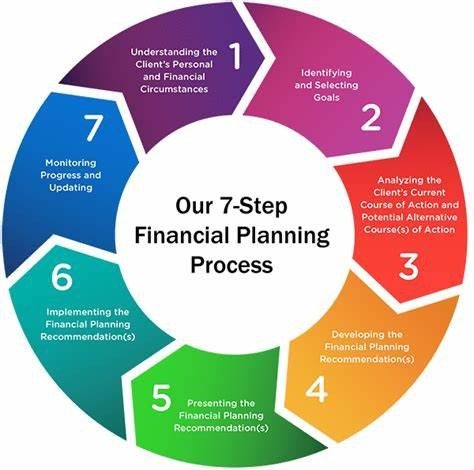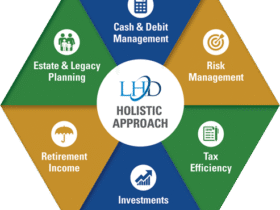Financial planning is the cornerstone of long-term financial stability and success. Without a structured approach, people often find themselves juggling debt, uncertain retirement prospects, or inconsistent savings habits. That’s where the 7 Step Financial Planning Process comes into play. Recognized by professionals worldwide and endorsed by the CFP® Board, this process provides a clear, organized path for individuals and families to understand their current situation, set realistic goals, and build strategies that lead to financial freedom. Whether you are just beginning your financial journey or looking to refine your existing plan, following these seven steps can make the difference between financial stress and financial confidence.
Step 1: Understanding Personal And Financial Circumstances
Every financial plan begins with an honest and thorough assessment of your current circumstances. This first step in the 7 Step Financial Planning Process involves gathering both qualitative and quantitative information. Quantitative data includes measurable items such as income, expenses, assets, debts, insurance coverage, and investment holdings. Qualitative information focuses on your values, health, career trajectory, family situation, and overall lifestyle goals.
By combining these two perspectives, a financial planner—or you, if managing your plan—gains a holistic view of your financial picture. For instance, someone with high income but excessive debt may have very different planning needs compared to someone with modest earnings but minimal liabilities. This stage is also about building trust between the advisor and client, as open communication ensures that all relevant details come to light. Skipping or rushing through this step often leads to weak foundations that compromise the entire plan.
Step 2: Identifying And Prioritizing Financial Goals
Once your current situation is clear, the next step is to define and prioritize your financial goals. Without clear objectives, even the most detailed financial plan will lack direction. In the 7 Step Financial Planning Process, goals are typically classified as:
- Short-term goals: e.g., creating an emergency fund within six months
- Medium-term goals: e.g., saving for a home in five years
- Long-term goals: e.g., retirement, funding children’s education, or leaving a legacy
A proven method to set meaningful objectives is the SMART framework—ensuring that goals are Specific, Measurable, Achievable, Relevant, and Time-bound. For example, “saving money for retirement” is vague, but “investing \$500 per month to reach a retirement nest egg of \$750,000 by age 65” is clear and measurable. Prioritizing goals is equally important; you may want to buy a luxury car, but if retirement savings are underfunded, shifting resources to the latter ensures financial security in the long run.
Step 3: Analyzing Current Strategies And Resources
The third step of the 7 Step Financial Planning Process involves carefully evaluating your existing strategies and resources to determine what is working and what needs adjustment. This means looking at your current savings rate, investment allocation, debt repayment methods, and insurance coverage. Are your investments diversified? Is your debt structured in a way that minimizes interest costs? Do you have enough liquidity to cover emergencies?
This step is a diagnostic process. Think of it as a financial health check-up where gaps, inefficiencies, and risks are identified. For example, you may discover that your insurance coverage is insufficient to protect your family in the event of a tragedy, or that your investment portfolio is too heavily weighted in one sector, exposing you to unnecessary risk. By analyzing these aspects, you can see whether your current approach aligns with the goals defined in step two or if adjustments are necessary to keep you on track.
Step 4: Developing Customized Financial Recommendations
Once the analysis is complete, it’s time to move into the planning stage. The fourth step of the 7 Step Financial Planning Process focuses on developing tailored recommendations that align with your circumstances and goals. This is where strategy takes shape. A financial planner may propose reallocating investments to balance risk and return, setting up a retirement account with tax advantages, increasing insurance coverage, or establishing an estate plan.
The key here is customization. Financial advice is not one-size-fits-all. What works for a young professional may be entirely different from the best strategy for a couple nearing retirement. Factors like risk tolerance, income stability, family responsibilities, and even personal values influence the recommendations. Advanced tools like financial modeling and scenario analysis can help illustrate how different strategies play out over time, giving you a clearer picture of the potential outcomes of your decisions.
Step 5: Presenting The Financial Plan Clearly
A plan is only as strong as your ability to understand and act on it. That’s why the fifth step of the 7 Step Financial Planning Process is about presenting the recommendations in a clear, structured, and easy-to-understand way. Financial concepts can be complex, but a good presentation breaks them down into digestible pieces. Advisors often use visual aids, written reports, and interactive dashboards to help clients grasp the plan’s details.
This stage also includes explaining the assumptions behind the recommendations, such as projected inflation rates, expected returns on investments, and anticipated life expectancy. By ensuring transparency, you build confidence in the plan and establish a roadmap that feels achievable. The presentation is also a chance to address any questions or concerns, ensuring that the client fully understands each recommendation and feels comfortable with the next steps.
Step 6: Implementing The Action Plan
After the financial plan is presented and agreed upon, the sixth step focuses on implementing the recommendations. Implementation can involve multiple tasks, such as opening new accounts, adjusting investment portfolios, refinancing loans, purchasing insurance policies, or updating estate planning documents.
The 7 Step Financial Planning Process recognizes that execution is often the most challenging stage because it requires commitment, coordination, and accountability. A financial planner may take on the responsibility of coordinating with other professionals like tax advisors, lawyers, or insurance agents. At the same time, clients must fulfill their obligations, such as transferring funds or signing legal documents. A detailed action plan with deadlines helps ensure that recommendations are carried out efficiently and without unnecessary delays.
Step 7: Monitoring Progress And Updating Regularly
The final step emphasizes that financial planning is not a one-time event but an ongoing process. Monitoring progress is crucial because life is dynamic, and circumstances can change rapidly. The 7 Step Financial Planning Process advises regular reviews—typically annually or after significant life events like marriage, the birth of a child, job changes, or market downturns.
During these reviews, the advisor and client revisit the goals, evaluate progress, and adjust strategies as needed. For example, if an investment underperforms or tax laws change, the plan must be updated to remain effective. Monitoring ensures that the plan stays aligned with the client’s evolving goals and external economic conditions. In this way, financial planning becomes a living document that grows and adapts with the client’s life journey.
Benefits Of Following The 7 Step Financial Planning Process
The structured approach of the 7 Step Financial Planning Process offers several benefits. First, it ensures a comprehensive evaluation of all aspects of your financial life, from income and expenses to insurance and estate planning. Second, it helps prioritize competing goals so that resources are allocated where they matter most. Third, the process builds accountability and confidence, as both clients and advisors know the exact steps to take. Finally, it creates flexibility by allowing adjustments over time, ensuring that the plan remains relevant no matter how circumstances change.
By following this process, individuals gain peace of mind knowing that their financial decisions are intentional, well-informed, and aligned with their long-term vision. Instead of reacting to crises or making impulsive choices, you have a roadmap that keeps you moving toward financial independence and stability.
Conclusion: Start Your 7 Step Financial Planning Journey Today
In a world of economic uncertainty, rising living costs, and ever-changing financial markets, having a clear plan is more important than ever. The 7 Step Financial Planning Process offers a time-tested, client-focused framework to take control of your financial future. From understanding your current circumstances to monitoring progress over time, each step builds on the last, creating a comprehensive strategy tailored to your unique goals and lifestyle.
Whether you work with a certified financial planner or take a do-it-yourself approach, adopting these seven steps will give you clarity, direction, and confidence. The earlier you begin, the greater the impact on your long-term success. Don’t wait for financial uncertainty to force decisions—start your structured planning journey today and create a future where your financial goals are not just dreams but achievable milestones.
Do Read: GoMyFinance.com Saving Money






